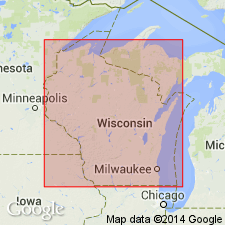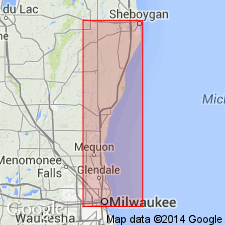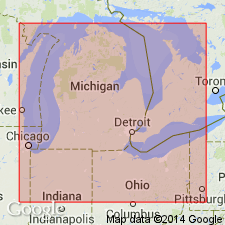
- Usage in publication:
-
- Thiensville formation
- Modifications:
-
- First used
- AAPG geologic province:
-
- Wisconsin arch
Summary:
Thiensville formation (provisional) of Raasch [ms] lies disconformably below the Milwaukee formation. The position of the provisional Ozaukee and Thiensville formations of Raasch [ms] is to the north, about 30 mi from Milwaukee, occupied by the Lake Church formation (provisional of Raasch), but since the types of animal life in either are entirely distinct they must not be considered as equivalent nor are they contemporary. Although in no place is the complete section of the latter seen, these beds are about 12 ft thick, and from them have come some of the most interesting pelecypods of the region. [Formations are not defined in this report.]
Source: GNU records (USGS DDS-6; Reston GNULEX).

- Usage in publication:
-
- Thiensville formation
- Modifications:
-
- Named
- Dominant lithology:
-
- Dolomite
- AAPG geologic province:
-
- Wisconsin arch
Summary:
Thiensville formation is composed mainly of dolomite of dark-chocolate, light-chocolate, or brownish-gray color, which may be massive and vesicular or finely laminated. In general it is moderately thick-bedded. Ranges from extremely firm and compact to highly porous. Many layers have bituminous odor. Thickness ranges 50 to 65 ft. Fossils remain largely undescribed. In Ozaukee Co., unit rests on Lake Church formation (Devonian) but south of Ozaukee-Milwaukee Co. line it lies on Silurian strata. Differs distinctly, lithologically and faunally, from Lake Church formation and from overlying Milwaukee formation (Middle Devonian). Has been removed by post-Devonian erosion north of type locality, which is cut on Hwy 57, 2 mi north of Thiensville, Ozaukee Co. Surface outcrops were formerly generally confused with Niagaran, and in subsurface borings it was formerly confused with the Waubakee.
Source: GNU records (USGS DDS-6; Reston GNULEX).

- Usage in publication:
-
- Thiensville Formation
- Modifications:
-
- Overview
- AAPG geologic province:
-
- Wisconsin arch
Summary:
Oldest Devonian rocks in Milwaukee. Informally subdivided into facies I, II, and III. Subsurface data suggest that the Lake Church Formation may be a facies (probably II) in the Thiensville, or that the Lake Church at its type may be equivalent to I and II. Raasch (1935) considered the Thiensville to be younger than the Lake Church. Formation was deposited under supratidal to intertidal conditions. Underlies Milwaukee Formation. Age is Middle Devonian (early Givetian).
Source: GNU records (USGS DDS-6; Reston GNULEX).
For more information, please contact Nancy Stamm, Geologic Names Committee Secretary.
Asterisk (*) indicates published by U.S. Geological Survey authors.
"No current usage" (†) implies that a name has been abandoned or has fallen into disuse. Former usage and, if known, replacement name given in parentheses ( ).
Slash (/) indicates name conflicts with nomenclatural guidelines (CSN, 1933; ACSN, 1961, 1970; NACSN, 1983, 2005, 2021). May be explained within brackets ([ ]).

